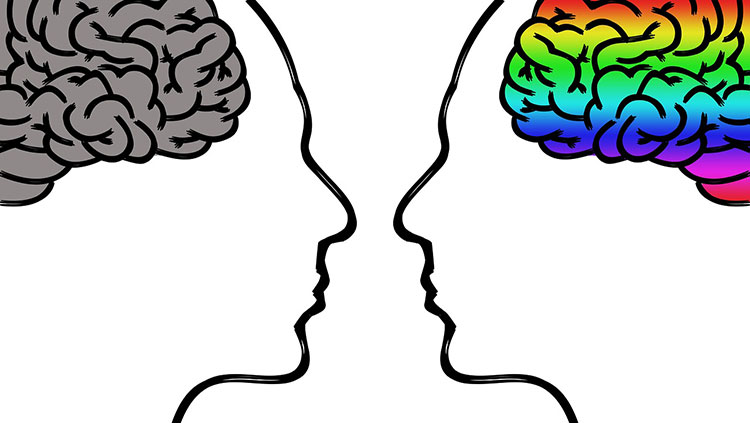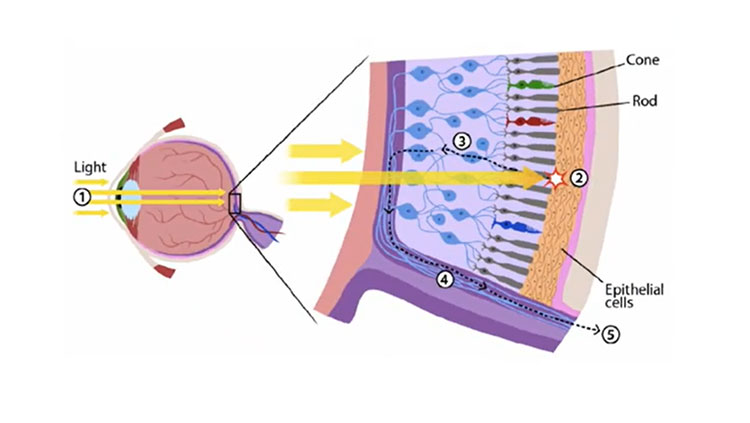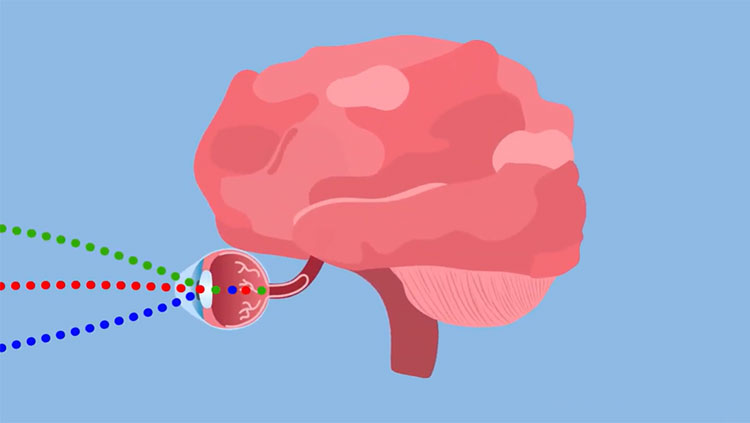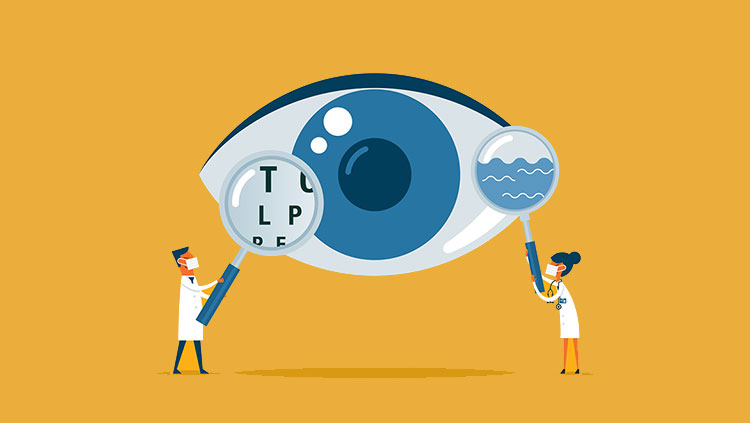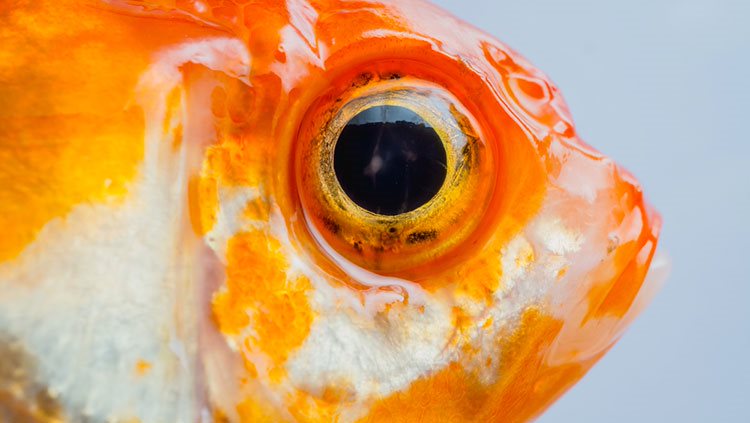The Senses — A Primer (Part II)
- Published25 Sep 2013
- Reviewed25 Sep 2013
- Source The Dana Foundation
Although sensory systems share basic features of organization, each is uniquely designed to respond to a particular aspect of the world. We might think of the principal senses as variations on a common theme.
Vision
While all the senses are important, we tend to rely most on sight. The brain devotes more space to processing and storing visual information than all other senses combined.
The cornea and lens, transparent structures at the front of the eye, focus light onto the retina, the photosensitive area that covers three-fourths of the back. The shape of the lens changes to adjust for near and distant vision.
The retina contains several layers of cells, but the actual sensory work is done by two kinds of photoreceptor cells in the deepest layer. Rods are sensitive enough to respond to dim light, but don’t process colors. Cone cells come in three subtypes that respond to wavelengths roughly corresponding to red, green, and blue light.
Light striking the surface of a photoreceptor activates a protein, rhodopsin, that initiates a chemical cascade of signals through intricate cellular wiring that ultimately converge in ganglion cells, neurons whose axons form the optic nerve. Processing, sorting, and condensing of signals actually starts here in the retina.
In the brain, visual input passes through intermediate areas to the primary, or striate, visual cortex in the occipital lobe, and then to a secondary visual cortex where the information separates into streams: dorsal pathways, which analyze image size and position; and ventral pathways that discriminate color and shape, allowing us to recognize what we see.
Scientists have identified brain structures specializing in faces, places, and words, among other things. All told, some 30 cortical areas participate in visual processing.
Hearing
The auditory system transforms mechanical energy—sound waves—into nerve impulses. Sounds enter the system via the inch-long ear canal, which terminates at the tympanic membrane (eardrum) whose vibrations represent an exquisitely complex response to pressure variations. A series of tiny bones (ossicles) in the middle ear amplify and transmit these vibrations to the cochlea of the inner ear, a fluid-filled tube rolled up like a snail shell.
Hair cells within the cochlea are the receptors of the auditory system. Movement of the membrane lining the cochlea stretches the tips of hair cells to allow an influx of K+ and Ca+2 ions—charged particles that build up to generate electrical signals in acoustic nerve fibers. The frequencies to which each hair cell responds depends on its position in the cochlea.
Auditory signals pass through intermediate brain regions to the primary auditory cortex in the temporal lobe. Direct connections facilitate quick reaction to loud sounds. Another pathway permits processing en route—coordinating signals from both ears, for example.
Past the primary auditory cortex, signals divide into streams that locate and analyze what we hear. The latter include Wernicke’s area in the dominant hemisphere, essential for language comprehension, and a right-hemisphere area that processes emotional aspects of speech.
Hearing is the first sense for which a device was developed to replace non-working receptors. By 2010, some 219,000 people had received cochlear implants, which restore functional hearing by directly stimulating the auditory nerve.
Taste and Smell
The receptors of the chemical sensory systems send electrical signals to the brain when they bind to airborne (for smell) and dissolved (taste) molecules.
Smell is the most primitive of the senses. Its role in finding food and warning of danger is vital for survival. The organization of the olfactory system is somewhat primitive too: receptors are dendrites of neurons that go directly to the brain. Within two or three synapses, the brain can recognize an odor.
Millions of olfactory receptors line the nasal passages, each designed to attach to specific molecules, activating a molecular cascade that generates action potentials within its neuron. The neurons terminate in the olfactory bulb, which computes signal patterns from 350 receptor types representing thousands of odors, and transmits this information to the piriform cortex for further processing.
The olfactory bulb connects directly to the limbic system, too. This link, which evolved to drive survival functions, is responsible for the intense emotions certain odors can instantaneously evoke. The sense of smell can also signal neurological degeneration: it is impaired early in Alzheimer’s and Parkinson’s disease.
Its simplicity notwithstanding, some mystery surrounds olfaction. Most scientists believe receptors respond to molecular shape; a minority that vibrational frequency is key. Pheromones—chemicals processed through the olfactory system to trigger hormonal responses—are vital to animal reproduction, but their human importance is highly controversial. It is uncertain, that is, whether such chemicals influence attraction, mate selection, or other aspects of sexual behavior. No true human pheromone has been identified. But airborne molecules of a male hormone have been shown to alter cortisol levels in women, and an estrogen derivative to stimulate hypothalamic activity (which could influence hormone secretion and mood) in men.
Molecules in solution bind to receptors on taste cells gathered in taste buds—about 10,000 such projections, most on the tongue but also elsewhere in the mouth and throat. Individual receptors respond to sweet, sour, bitter, and salty taste—and “umami” (described as “meaty” or “savory”), now widely recognized as a fifth taste.
While it was once thought that zones of the tongue were taste-specific, all areas actually respond to all tastes (although some are particularly sensitive to one or another). Indeed, some conjecture that even a single taste bud may hold receptors for several tastes.
Molecules binding to taste receptors start a series of chemical reactions (or, in the case of salty and sour, simply open ion channels) to generate action potentials in cranial nerves. These impulses converge on the medulla oblongata in the brainstem, and move on to cortical and limbic areas. Via these pathways, taste signals influence digestive processes, emotions, and food decisions. Some taste responses are all but universal (preference for sweetness, for example), but others are idiosyncratic, a combination of genetics (why some people find broccoli bitter, for example) and experience. What’s usually called the “taste” of food properly refers to flavor, a complex phenomenon that also includes smell and qualities like texture.
Somatosensory System
The "fifth sense," touch, is actually one of several that operate through the peripheral, spinal, and cranial nerves of the somatosensory system: others are proprioception (body position and movement), temperature, and pain.
There is no compact sense organ (like the eye or ear) to house touch receptors: they are distributed in skin all over the body. Unlike those of other senses, the vast majority of touch receptors are not specialized cells, but simply axon terminals of neurons connected to spinal or cranial nerve tracts, encapsulated in non-neural structures. Mechanical forces on these receptors open ion channels, generating electrical signals.
Touch receptors specialize: some are sensitive to light touch, others to vibration or pressure. Their signals travel in separate fibers via the spinal cord or cranial nerves to the brain stem, and then to the somatosensory cortex in the parietal lobe, where they map onto a somewhat distorted projection of the body. Brain areas corresponding to parts where touch receptors are concentrated (e.g. fingers and face) are much larger than where they are sparse.
Proprioceptive receptors are axon terminals in muscles and joints, housed in structures responsive to stretch or tension, pressure or movement.
Temperature and pain receptors (nociceptors) are bare nerve endings. A “fast” pathway transmits localized pain caused by mechanical forces or cold; the "slow" pathway carries dull, deep pain generated by chemicals (like substance P) released by damaged tissue. Connections to the anterior cingulate cortex modulate the emotional response to pain.
Along with touch and proprioception, pain signals converge on the somatosensory cortex to create a unified sense of the body.
More broadly, the foregoing descriptions of separate systems notwithstanding, data from all the senses are integrated in the brain, in ways just beginning to be understood, enabling us to navigate a coherent world.
- Carl Sherman
CONTENT PROVIDED BY
The Dana Foundation is a private philanthropic organization that supports brain research through grants and educates the public about the successes and potential of brain research.
References
Shepherd, G M. The Major Senses: Sight, Hearing, Smell, Taste, and Touch—The Dana Guide. Dana Foundation website. November 2007 http://www.dana.org/news/brainhealth/detail.aspx?id=10064
The Brain from Top to Bottom: The Senses: Vision. Canadian Institute of Health Research; Institute of Neurosciences, Mental Health and Addiction. http://thebrain.mcgill.ca/flash/a/a_02/a_02_cr/a_02_cr_vis/a_02_cr_vis.html
Baldassano C, Beck DM, Fei-Fei L Differential connectivity within the Parahippocampal Place Area. Neuroimage. 2013 Jul 15;75:228-37. Epub 2013 Mar 16. http://www.ncbi.nlm.nih.gov/pubmed/23507385
Dehaene, S. Inside the Letterbox: How Literacy Transforms the Human Brain. Cerebrum. June 03, 2013. http://dana.org/news/cerebrum/detail.aspx?id=43644
Henshaw, J. M. A Tour of the Senses: how your brain interprets the world. Johns Hopkins University Press. 2012
Neuroscience Online: an electronic textbook for the neurosciences. Sensory Systems—auditory systems: structure and function. University of Texas Medical School. http://neuroscience.uth.tmc.edu/s2/chapter12.html
Bossomaier, T. R. J. Introduction to the Senses: from biology to computer science. Cambridge University Press. 2012
Wildgruber D, Riecker A, et al. Identification of emotional intonation evaluated by fMRI. Neuroimage. 2005 Feb 15;24(4):1233-41. Epub 2004 Dec 15. http://www.ncbi.nlm.nih.gov/pubmed/15670701
National Institute on Deafness and other Communication Disorders: Cochlear Implants. http://www.nidcd.nih.gov/health/hearing/pages/coch.aspx
Monell Chemical Senses Center: advancing discovery in taste and smell. http://www.monell.org/news/category/fact_sheets
Neuroscience Online: an electronic textbook for the neurosciences: Sensory systems—Chemical Senses: Olfaction and Gustation. University of Texas Medical School. http://neuroscience.uth.tmc.edu/s2/chapter09.html
Brynie, F.H. Brain Sense: the science of the senses and how we process the world around us. Amacom. 2009
Beauchamp GK. Sensory and receptor responses to umami: an overview of pioneering work. Am J Clin Nutr. 2009 Sep;90(3):723S-727S. doi: 10.3945/ajcn.2009.27462E. Epub 2009 Jul 1.
Wyart C, Webster WW, Chen JH, et al. Smelling a single component of male sweat alters levels of cortisol in women. J Neurosci. 2007 Feb 7;27(6):1261-5. http://www.jneurosci.org/content/27/6/1261.long
Savic I, Berglund H, et al. Smelling of odorous sex hormone-like compounds causes sex-differentiated hypothalamic activations in humans. Neuron. 2001 Aug 30;31(4):661-8.
Neuroscience Online: an electronic textbook for the neurosciences: Sensory systems—Somatosensory systems. University of Texas Medical School. http://neuroscience.uth.tmc.edu/s2/chapter02.html
Rosenblum, L. D, A confederacy of senses. Sci Am. 2013 Jan;308(1):72-5.
Also In Vision
Trending
Popular articles on BrainFacts.org



